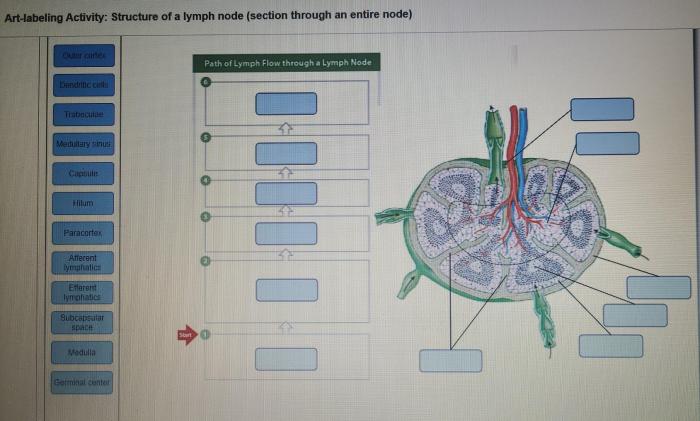Art-labeling activity location and structure of lymph nodes – Art-labeling activities offer a captivating and educational approach to understanding the location and structure of lymph nodes. By engaging students in artistic representations, these activities foster a deeper comprehension of the lymphatic system and its crucial role in the immune system.
Delving into the intricacies of lymph nodes, their strategic positioning throughout the body, and their intricate internal components, art-labeling activities provide a tangible and memorable learning experience.
Art-labeling Activity: Location and Structure of Lymph Nodes

This article explores the concept of art-labeling activities, their importance in education, and their potential applications in teaching about the location and structure of lymph nodes. It provides a detailed description of lymph nodes, their role in the immune system, and how art-labeling activities can enhance student understanding of these structures.
Art-labeling Activity
Art-labeling activities involve students labeling anatomical structures on an image or diagram. This helps them visualize and comprehend complex anatomical concepts.
Importance in Education:
- Improves visual memory and spatial reasoning
- Facilitates deeper understanding of anatomical structures
- Engages students and makes learning more interactive
Examples:
- Labeling a diagram of the lymphatic system
- Annotating a microscope image of a lymph node
- Creating a 3D model of a lymph node with labeled components
Location and Structure of Lymph Nodes
Lymph nodes are small, bean-shaped structures located throughout the body. They are part of the lymphatic system, which plays a crucial role in the immune response.
Location:
- Found in clusters along lymphatic vessels
- Common locations include the neck, armpits, and groin
Structure:
- Outer cortex contains lymphoid follicles with B cells
- Inner medulla contains lymphoid cords with T cells
- Germinal centers are sites of antibody production
- Sinuses allow lymph to flow through the node
Role in the Immune System:
- Filter and trap pathogens
- Produce antibodies and activate immune cells
- Contribute to the development of immunological memory
Interrelation between Art-labeling Activities and Lymph Nodes, Art-labeling activity location and structure of lymph nodes
Art-labeling activities can help students understand the location and structure of lymph nodes by:
- Providing a visual representation of the anatomical structures
- Facilitating the labeling of specific components
- Encouraging students to analyze the relationships between structures
Examples:
- Labeling a diagram of the lymphatic system to identify lymph node locations
- Creating a cross-sectional model of a lymph node to visualize its internal structure
- Using virtual reality simulations to explore lymph nodes in 3D
Applications in Education
Lesson Plan:
Topic:The Location and Structure of Lymph Nodes
Materials:
- Diagram of the lymphatic system
- Labeling sheets
- Colored pencils
Procedure:
- Introduce the concept of lymph nodes and their role in the immune system.
- Distribute diagrams of the lymphatic system to students.
- Instruct students to label the lymph nodes and their major components.
- Discuss the location and structure of lymph nodes based on the labeled diagrams.
Assessment:
- Evaluate student labeling sheets for accuracy and completeness.
- Assess student understanding through a quiz or discussion.
Differentiation:
- Provide students with different levels of scaffolding, such as pre-labeled diagrams or a list of terms.
- Offer alternative activities for students with diverse learning needs, such as creating a 3D model of a lymph node.
User Queries: Art-labeling Activity Location And Structure Of Lymph Nodes
What are the benefits of using art-labeling activities to teach about lymph nodes?
Art-labeling activities enhance visual learning, promote deeper understanding through artistic representations, and stimulate creativity in the learning process.
How can art-labeling activities be differentiated for students with diverse learning needs?
Differentiation can be achieved by providing varying levels of support, such as pre-labeled diagrams, simplified instructions, or multi-sensory materials.



